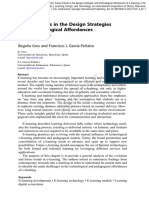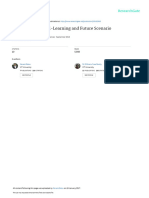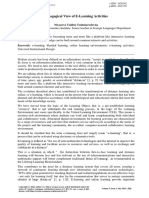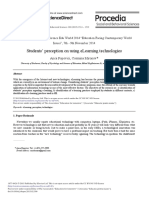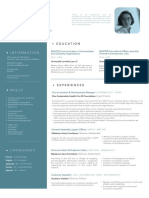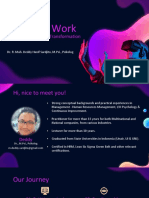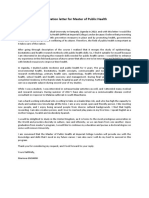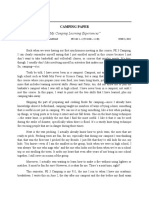SEMINAR ON
E-LEARNING
BY
ABDULRAHMAN AHMAD
MAT.NO: 2021/147628CS
LEVEL: NDII
OF THE
DEPARTMENT OF COMPUTER SCIENCE
SCHOOL OF INFORMATION COMMUNICATION AND
TECHNOLOGY
THE FEDERAL POLYTECHNIC BIDA.
AUGUST 2024
� Abstract
E-learning, or electronic learning, has transformed the education sector by leveraging digital
technologies to deliver educational content and facilitate learning. This seminar explores the
evolution of e-learning, its current trends, and future directions. It examines the impact of
technological advancements, analyzes contemporary practices, and discusses emerging
trends and potential challenges. The objective is to provide a comprehensive understanding
of e-learning's role in modern education and its implications for learners and educators.
1
� Aim and Objectives
Aim:
To explore the evolution, current trends, and future directions of e-learning,
examining its impact on education, analyzing contemporary practices, and
discussing emerging trends and potential challenges.
Objectives:
1. To review the core concepts and technological foundations of e-learning.
2. To analyze the impact of e-learning on education, including its
accessibility, engagement, and cost-effectiveness.
3. To evaluate current trends, emerging technologies, and potential
challenges associated with e-learning.
2
� Background of the Study and Introduction
E-learning refers to the use of electronic media and information technologies to
support, enhance, or deliver education and training (Anderson, 2008). This
approach encompasses a wide range of formats and methods, including online
courses, virtual classrooms, and digital resources, enabling learners to access
educational content remotely and asynchronously (Bates, 2015). E-learning has
become increasingly prevalent due to its flexibility, accessibility, and cost-
effectiveness, making it a crucial component of modern education systems.
The development of e-learning has been driven by advancements in internet
technology, multimedia tools, and instructional design. These innovations have
facilitated the creation of interactive and engaging learning experiences,
fostering greater learner engagement and achievement (Garrison & Vaughan,
2008). Understanding the evolution of e-learning, along with current trends and
future directions, is essential for optimizing its impact and addressing emerging
challenges.
3
� DISCUSSION OF FINDING
Review of Literature
1. Core Concepts of E-Learning
Definitions and Models: E-learning encompasses various definitions and
models, including synchronous and asynchronous learning, blended
learning, and mobile learning (Miller & Loney, 2019). Synchronous
learning involves real-time interaction, while asynchronous learning
allows learners to access content at their own pace. Blended learning
combines traditional face-to-face instruction with online components, and
mobile learning leverages mobile devices for learning on-the-go (Clark &
Mayer, 2016).
Technological Foundations: E-learning relies on a range of technologies,
including Learning Management Systems (LMS), video conferencing
tools, and digital content platforms (Watson & Watson, 2007). LMS
platforms, such as Moodle and Blackboard, provide a centralized
environment for managing and delivering educational content, while
video conferencing tools enable live interactions between instructors and
learners.
2. Impact on Education and Learning
Accessibility and Flexibility: E-learning provides access to educational
resources from anywhere, at any time, enabling learners to engage with
content according to their schedules and needs (Bates, 2015). This
flexibility is particularly beneficial for learners with diverse backgrounds
and constraints.
4
� Engagement and Interactivity: Interactive elements, such as multimedia
content, quizzes, and discussion forums, enhance learner engagement and
motivation (Clark & Mayer, 2016). E-learning platforms often
incorporate gamification and adaptive learning technologies to create
personalized and engaging learning experiences.
Cost-Effectiveness: E-learning reduces costs associated with traditional
education methods, such as travel, accommodation, and physical
materials (Garrison & Vaughan, 2008). It allows educational institutions
to reach a larger audience with minimal incremental costs.
3. Current Trends and Developments
Mobile Learning: The proliferation of smartphones and tablets has led to
the rise of mobile learning, enabling learners to access educational
content and participate in activities using mobile devices (Kukulska-
Hulme & Traxler, 2007). Mobile learning offers convenience and
flexibility, supporting learning in diverse contexts.
Social Learning: Social learning platforms and tools, such as discussion
forums, social media, and collaborative projects, facilitate peer
interaction and knowledge sharing (Siemens, 2014). These tools enhance
the learning experience by fostering community and collaboration.
Artificial Intelligence (AI) and Machine Learning: AI and machine
learning technologies are increasingly being integrated into e-learning
platforms to provide personalized learning experiences, automate
administrative tasks, and analyze learning data (Heffernan & Heffernan,
2014). These technologies enhance the effectiveness and efficiency of e-
learning.
5
�Analysis of Past and Present
1. Historical Evolution of E-Learning
Early Developments: E-learning has evolved from early forms of
computer-based training and distance education to sophisticated online
learning environments (Watson & Watson, 2007). The introduction of the
internet and web technologies in the 1990s marked a significant milestone,
enabling more interactive and accessible e-learning experiences.
Growth and Expansion: The growth of e-learning has been fueled by
advancements in technology, increased internet penetration, and the
demand for flexible learning solutions (Bates, 2015). The proliferation of
online courses, MOOCs (Massive Open Online Courses), and digital
resources has expanded the reach and impact of e-learning.
2. Current Practices and Innovations
Integration of Multimedia and Interactive Elements: Modern e-
learning platforms incorporate multimedia content, such as videos,
simulations, and interactive exercises, to enhance the learning experience
(Clark & Mayer, 2016). These elements engage learners and support
various learning styles.
Data-Driven Insights: The use of data analytics in e-learning provides
valuable insights into learner behavior, performance, and engagement
(Heffernan & Heffernan, 2014). These insights inform instructional
design and help educators tailor content to meet learners' needs.
Futures
1. Emerging Trends in E-Learning
6
� Virtual Reality (VR) and Augmented Reality (AR): VR and AR
technologies are poised to transform e-learning by providing immersive
and interactive learning experiences (Bower et al., 2017). These
technologies enable learners to explore and interact with virtual
environments and simulations.
Blockchain Technology: Blockchain technology has the potential to
enhance e-learning by providing secure and transparent credentials,
certificates, and records (Grech & Camilleri, 2017). Blockchain-based
solutions can improve the verification and management of educational
qualifications.
Adaptive Learning: Adaptive learning technologies use algorithms to
tailor educational content and experiences to individual learners' needs
and preferences (Cleveland-Innes & Campbell, 2012). This approach
enhances personalization and improves learning outcomes.
2. Potential Challenges and Considerations
Digital Divide: The digital divide remains a challenge, as access to
technology and the internet varies across regions and populations
(Selwyn, 2016). Addressing this disparity is essential for ensuring
equitable access to e-learning opportunities.
Privacy and Security: Ensuring the privacy and security of learners' data
is crucial in e-learning environments (Bower et al., 2017). Educational
institutions and platforms must implement robust measures to protect
sensitive information and comply with data protection regulations.
7
� Summary
E-learning has significantly impacted the education sector by providing flexible,
accessible, and cost-effective learning solutions. This seminar has explored the
core concepts, historical development, current practices, and future trends
related to e-learning. We reviewed the impact of e-learning on education,
analyzed emerging trends, and discussed potential challenges and opportunities.
Conclusion
E-learning continues to evolve, driven by technological advancements and
changing educational needs. Understanding the impact of e-learning and staying
informed about emerging trends will enable educators and learners to leverage
its full potential and address associated challenges effectively.
Recommendations
Explore Emerging Technologies: Investigate and integrate emerging
technologies, such as VR, AR, and AI, to enhance e-learning experiences
and improve learning outcomes.
Address the Digital Divide: Implement strategies to address disparities
in access to technology and the internet, ensuring equitable access to e-
learning opportunities.
Enhance Security and Privacy: Adopt robust measures to protect
learners' data and comply with data protection regulations.
Embrace Data-Driven Insights: Utilize data analytics to gain insights
into learner behavior and performance, informing instructional design and
content development.
8
� References
Anderson, T. (2008). The Theory and Practice of Online Learning. Athabasca
University Press.
Bates, A. T. (2015). Teaching in a Digital Age: Guidelines for Designing
Teaching and Learning. Tony Bates Associates Ltd.
Bower, M., Howe, C., McCredie, N., Robinson, D., & Grover, D. (2017).
Augmented Reality in Education – Cases, Places, and Potentials. Educational
Media International, 54(3), 251-269.
Clark, R. C., & Mayer, R. E. (2016). E-Learning and the Science of Instruction:
Proven Guidelines for Consumers and Designers of Multimedia Learning.
Wiley.
Cleveland-Innes, M., & Campbell, P. (2012). Adaptive Learning Technologies:
From Personalization to Prediction. Educational Technology Research and
Development, 60(6), 855-872.
Garrison, D. R., & Vaughan, N. D. (2008). Blended Learning in Higher
Education: Framework, Principles, and Guidelines. Jossey-Bass.
Grech, A., & Camilleri, A. F. (2017). Blockchain in Education. European
Journal of Open, Distance and E-Learning, 20(1).
Heffernan, N. T., & Heffernan, C. L. (2014). The Impact of Learning Analytics
on Education: A Review of the Evidence. International Journal of Artificial
Intelligence in Education, 24(1), 87-104.
Kukulska-Hulme, A., & Traxler, J. (2007). Mobile Learning: A Handbook for
Educators and Trainers. Routledge.


